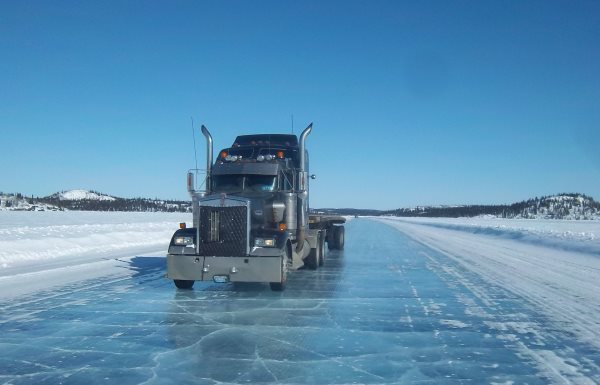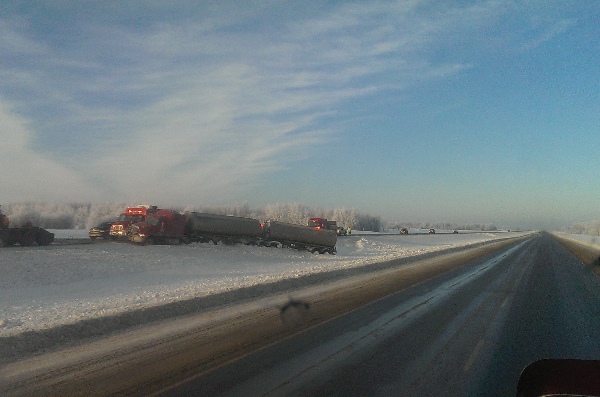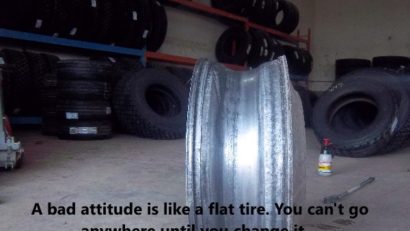Snow
Packed snow is my favourite oilfield driving condition to drive on, mostly because I hate mud. I also don’t care for gravel because I like my windshield intact. Windshields don’t last very long with rocks being kicked up from passing vehicles on gravel roads.
There are many rules and speed limits posted regarding passing other vehicles and the unwritten rule is slow down as much as possible. 40 to 50 km/hr is considered a safe and courteous speed. Just because there isn’t a sign to tell you what to do, it shouldn’t prevent you from being courteous.
The great thing about snow is knowing what you’re driving on. You can adjust your speed accordingly. It’s far nicer than driving on a highway that may have black ice or glaze.
Slow down and stay well back of snow dust being kicked up from vehicles in front of you and slow down when passing vehicles going the other way. (Don’t dust them out with your snow cloud). I already mentioned you’re paid by the hour, so what’s the rush? The roads are extremely narrow, so a snow dust cloud can easily put others in the ditch.
Be careful of freshly graded roads after a snowstorm. Finding the edge of the road could be a costly mistake. If a plow blade is level with the road, it can appear like the road is wider than it actually is.
Oilfield Ice Roads
Muskeg Ice roads in the oilfields are built by water trucks flooding the road like a hockey rink. They build thick layers of ice to be able to support the heavy vehicles on top of muskeg areas. You’ll rarely be allowed to run chains on man made ice roads, so slower controlled driving is important.
The only positive thing about Muskeg ice roads, is you’ll rarely have any hills to worry about. A muskeg is a low lying bog or swampy area.
Steep Grades and Chaining Up
This is the big one. Steep grades are where most people seem to get into trouble. The biggest reason is the drivers lack of judgement regarding when to put on truck tire chains.
If you’re unsure, you probably need them. Especially if you’re new and don’t know the roads you’re traveling on. Truck chains are very cheap insurance that make the roads safer for everyone and they cover your butt if anything should happen.
Putting on tire chains at the right time is not the easiest call to make, and we all learn lessons the hard way. Chaining up when you’re spun out on a hill has some serious safety risks. There’s nothing worse than holding the chains in your hands as you watch your truck and trailer sliding away on you.
This may sound funny, but many oilfield truckers can relate to this. Don’t ever get complacent just because you’re familiar with a road and the hills. Most experienced drivers that think they can do it, or have done it before are the ones that get caught in complacency. This is always the time when some unknown hazard will get you.
It could be anything from a change in road conditions, to an accident scene where people are out of their vehicles, or another driver failing to use chains that spun out. Don’t count on other’s to warn you of these hazards on the radio, because this isn’t always possible. (Especially if it just happened).

Oilfield Driving has many deceiving hazards especially at night. This hill may not be big, but there’s a rough bridge before it and the grade is over 15%.
Look at the picture above and imagine your first time on this road at night. The terrain may be relatively flat in the area and you decided you wouldn’t need chains. There is very little chance to run at a small steep hill like this with a rough temporary bridge before it. The tow tractor operator may not be around. If you spin out on this hill, you’ll be coming down backwards in icy conditions.
You don’t chain up for what you know, you chain up for what you don’t know.
As driver’s, we’re more prepared for what we know will challenge us like the mountain pass, the big hill, or the sharp bend. We know these things are coming and we can prepare for them. In Oilfield Driving, there’s far more unknown challenges and they increase at night where so much of our work takes place.
When a driver knows a road they can easily become complacent. A “drivers edge” is a slight level of caution when they drive on snow, ice, challenging, or unknown terrain. This edge is what keeps them in check. This edge can disappear when you become complacent and can be easily replaced with aggression, according to how well they know a section of road or terrain.
Sadly, I believe that we can all be guilty of this. Here’s an example of what I mean.
If you’ve lived on a road for 30 years and you come home in a thick fog, do you ever overdrive your vision?
The truth is, the better we know a road, the more dangerous we can become. This is the opposite of what one might expect, but it’s human nature. You won’t ever see a race car driver doing test runs on a track so they can be more cautious and safe. They are “learning” the track so they can attack it more aggressively.








